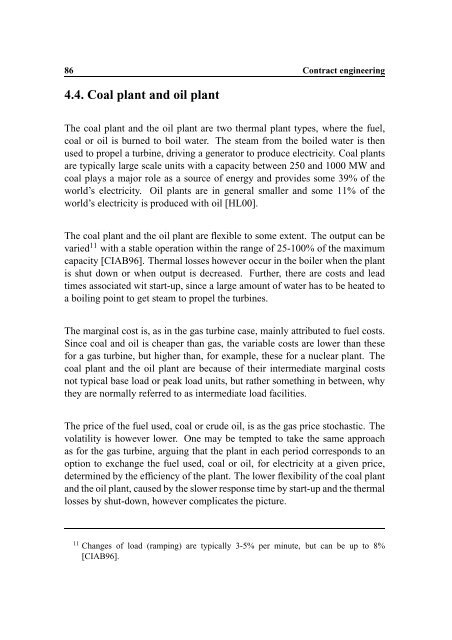Hedging Strategy and Electricity Contract Engineering - IFOR
Hedging Strategy and Electricity Contract Engineering - IFOR
Hedging Strategy and Electricity Contract Engineering - IFOR
You also want an ePaper? Increase the reach of your titles
YUMPU automatically turns print PDFs into web optimized ePapers that Google loves.
86 <strong>Contract</strong> engineering<br />
4.4. Coal plant <strong>and</strong> oil plant<br />
The coal plant <strong>and</strong> the oil plant are two thermal plant types, where the fuel,<br />
coal or oil is burned to boil water. The steam from the boiled water is then<br />
used to propel a turbine, driving a generator to produce electricity. Coal plants<br />
are typically large scale units with a capacity between 250 <strong>and</strong> 1000 MW <strong>and</strong><br />
coal plays a major role as a source of energy <strong>and</strong> provides some 39% of the<br />
world’s electricity. Oil plants are in general smaller <strong>and</strong> some 11% of the<br />
world’s electricity is produced with oil [HL00].<br />
The coal plant <strong>and</strong> the oil plant are flexible to some extent. The output can be<br />
varied 11 with a stable operation within the range of 25-100% of the maximum<br />
capacity [CIAB96]. Thermal losses however occur in the boiler when the plant<br />
is shut down or when output is decreased. Further, there are costs <strong>and</strong> lead<br />
times associated wit start-up, since a large amount of water has to be heated to<br />
a boiling point to get steam to propel the turbines.<br />
The marginal cost is, as in the gas turbine case, mainly attributed to fuel costs.<br />
Since coal <strong>and</strong> oil is cheaper than gas, the variable costs are lower than these<br />
for a gas turbine, but higher than, for example, these for a nuclear plant. The<br />
coal plant <strong>and</strong> the oil plant are because of their intermediate marginal costs<br />
not typical base load or peak load units, but rather something in between, why<br />
they are normally referred to as intermediate load facilities.<br />
The price of the fuel used, coal or crude oil, is as the gas price stochastic. The<br />
volatility is however lower. One may be tempted to take the same approach<br />
as for the gas turbine, arguing that the plant in each period corresponds to an<br />
option to exchange the fuel used, coal or oil, for electricity at a given price,<br />
determined by the efficiency of the plant. The lower flexibility of the coal plant<br />
<strong>and</strong> the oil plant, caused by the slower response time by start-up <strong>and</strong> the thermal<br />
losses by shut-down, however complicates the picture.<br />
11 Changes of load (ramping) are typically 3-5% per minute, but can be up to 8%<br />
[CIAB96].
















